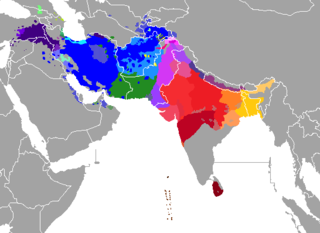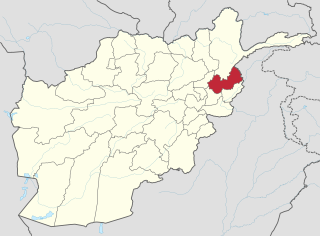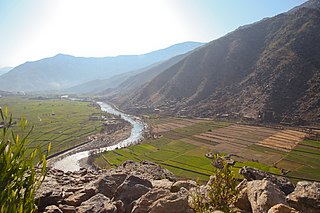Related Research Articles

The Indo-Iranian languages constitute the largest and southeasternmost extant branch of the Indo-European language family, predominantly spoken in the geographical subregion of Southern Asia. They have more than 1.5 billion speakers, stretching from Europe (Romani), Mesopotamia and the Caucasus eastward to Xinjiang (Sarikoli) and Assam (Assamese), and south to Sri Lanka (Sinhala) and the Maldives (Maldivian), with branches stretching as far out as Oceania and the Caribbean for Fiji Hindi and Caribbean Hindustani respectively. Furthermore, there are large diaspora communities of Indo-Iranian speakers in northwestern Europe, North America, Australia, South Africa, and the Persian Gulf Region.

The Indo-Aryan languages are a branch of the Indo-Iranian languages in the Indo-European language family. As of the early 21st century, they have more than 800 million speakers, primarily concentrated in India, Pakistan, Bangladesh, Nepal, Sri Lanka, and Maldives. Moreover, apart from the Indian subcontinent, large immigrant and expatriate Indo-Aryan–speaking communities live in Northwestern Europe, Western Asia, North America, the Caribbean, Southeast Africa, Polynesia and Australia, along with several million speakers of Romani languages primarily concentrated in Southeastern Europe. There are over 200 known Indo-Aryan languages.

The Nuristani languages, formerly known as Kafiri languages, are one of the three groups within the Indo-Iranian language family, alongside the much larger Indo-Aryan and Iranian groups. They have approximately 130,000 speakers primarily in eastern Afghanistan and a few adjacent valleys in Khyber Pakhtunkhwa's Chitral District, Pakistan. The region inhabited by the Nuristanis is located in the southern Hindu Kush mountains, and is drained by the Alingar River in the west, the Pech River in the center, and the Landai Sin and Kunar rivers in the east. The languages were previously often grouped with Indo-Aryan or Iranian until they were finally classified as forming a third branch in Indo-Iranian.

The Dardic languages or Hindu-Kush Indo-Aryan languages, are a group of several Indo-Aryan languages spoken in northern Pakistan, northwestern India and parts of northeastern Afghanistan.
The Katir are a Nuristani tribe in Afghanistan and Pakistan.

Khowar or Chitrali, is an Indo-Aryan language primarily spoken in Chitral and surrounding areas in Pakistan.

Dameli (دَميلي), also Damia, Damiabaasha or Gidoj, is an Indo-Aryan language of the Dardic subgroup spoken by approximately 5,000 people in the Domel Town, in the Chitral District of Khyber-Pakhtunkhwa province of Pakistan.

Kalasha is an Indo-Aryan language spoken by the Kalash people, in the Chitral District in Pakistan. There are an estimated 5,000 speakers of Kalasha. It is an endangered language and there is an ongoing language shift to Khowar.

Palula and also known as Ashreti (Aćharêtâʹ) or Dangarikwar, is an Indo-Aryan language spoken by approximately 10,000 people in the valleys of Ashret and Biori, as well as in the village of Puri in the Shishi valley and at least by a portion of the population in the village Kalkatak, in the Chitral District of Khyber Pakhtunkhwa province of Pakistan.

Gawar-Bati or Narsati is an Indo-Aryan language spoken in the Chitral region of northern Pakistan, and across the border in Afghanistan. It is also known as Aranduyiwar in Chitral because it is spoken in Arandu, which is the last village in lower Chitral and is also across the border from Berkot in Afghanistan. There are about 9,000 speakers of Gawar-Bati, with 1,500 in Pakistan, and 7,500 in Afghanistan. The name Gawar-Bati means "speech of the Gawar", a people detailed by the Cacopardos in their study of the Hindu Kush.

Torwali is an Indo-Aryan language mainly spoken in the Bahrain and Chail areas of the Swat District in Pakistan. The language and other non-Pashtun communities are often referred to as "Kohistani" which is a name given by the Swat Pashtuns. Fredrik Barth says "The Pathans call them, and all other Muhammadans of Indian descent in the Hindu Kush valleys, Kohistanis". The Torwali language is said to have originated from the pre-Muslim communities of Swat. It is the closest modern Indo-Aryan language still spoken today to Niya, a dialect of Gāndhārī, a Middle Indo-Aryan language spoken in the ancient region of Gandhara.
Tregami (Trigami), or Katar Gambiri, is a language spoken in the villages of Gambir, Kaṭâr, and Devoz in the Tregâm Valley off the lower Pech River in the Watapur District of Kunar Province in Afghanistan. The area is in the Hindu Kush along the border with Pakistan. Tregami belongs to the Nuristani group of the Indo-Iranian language family. It is spoken by approximately 3,500 people (2011). Most individuals speak Pashto in addition to Tregami.
Waigali is a language spoken by about 10,000 Nuristani people of the Waigal Valley in Afghanistan's Nuristan Province. The native name is Kalaṣa-alâ 'Kalasha-language'. "Waigali" refers to the dialect of the Väy people of the upper part of the Waigal Valley, centered on the town of Waigal, which is distinct from the dialect of the Čima-Nišei people who inhabit the lower valley. The word 'Kalasha' is the native ethnonym for all the speakers of the southern Nuristani languages.
Kata-vari is a dialect of the Kamkata-vari language spoken by the Kata in parts of Afghanistan and Pakistan. The most used alternative names are Kati, Kativiri or Bashgali.
Wasi-wari is the language of the Wasi people, spoken in a few villages in the Pârun Valley in Afghanistan. It also goes by the name Prasun or Paruni.

The Brokpa, sometimes referred to as Minaro, are a small ethnic group mostly found in the union territory of Ladakh, India around the villages of Dha and Hanu. Some of the community are also located across the Line of Control in Baltistan, in the villages around Ganokh. They speak an Indo-Aryan language called Brokskat. The Brokpa are mostly Vajrayana Buddhist while some are Muslim. A small percentage also follow Hinduism.

Indus Kohistani is an Indo-Aryan language spoken in the former Kohistan District of Pakistan. The language was referred to as Maiyã (Mayon) or Shuthun by early researchers, but subsequent observations have not verified that these names are known locally.

Watapur District is situated in the central part of Kunar Province in Afghanistan. It was split from Asadabad district. The district is mountainous with 60 large and small villages. The population is around 60,000. Degan, Safi, Ragakhel, Sharbekhel, Nanekhel, Doshakhel, Kohestani, Saidan are the few tribes living in this beautiful place. Watapur District has a high school located in south part of the district. The villages are located in the valleys or in the high mountains, with difficult or no road access to the center - Asadabad, and it takes one day to reach some of them. There was a medical clinic north of Qatar Kala, built by ISAF, until it was destroyed by local militants.
The Yashkun People or Yashkuns are a sub-group of the Shina, a Dardic-speaking ethnic group, majority of whom reside in the Gilgit division of Gilgit-Baltistan and Chitral and Kohistan districts of Khyber-Pakhtunkhwa, Pakistan. They speak a Dardic language called Shina and are generally scattered throughout northern Pakistan. Most researchers assert that the Yashkun are immigrants to northern Pakistan from Central Asia. However, other authorities maintain that the Yashkuns are indigenous to northern Pakistan.
Kalasha language may refer to:
References
- ↑ Wotapuri-Katarqalai at Ethnologue (25th ed., 2022)

- ↑ Ėdelʹman, Dzohoĭ Iosifovna (1983). The Dardic and Nuristani Languages. "Nauka" Publishing House, Central Department of Oriental Literature, 1983.
- ↑ Edelman, D. I. (1983). The Dardic and Nuristani Languages. Moscow: (Institut vostokovedenii︠a︡ (Akademii︠a︡ nauk SSSR). p. 139.